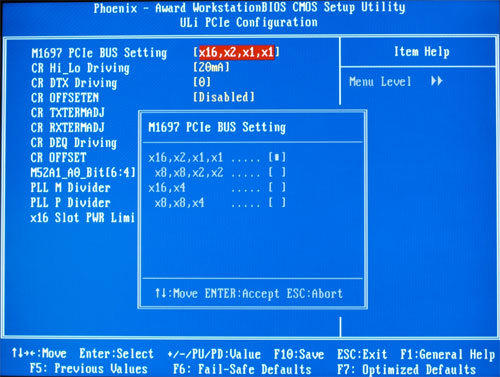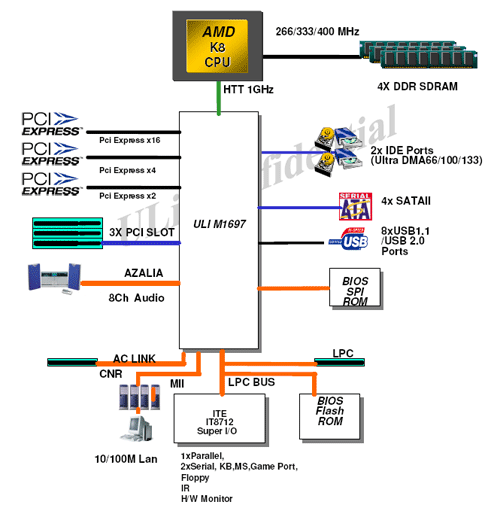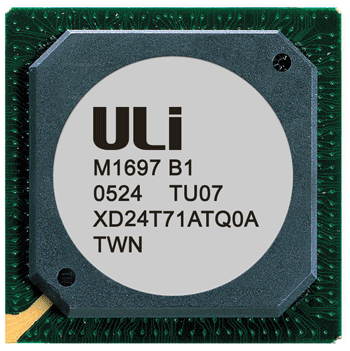FIRST LOOK: ULi M1697 for Athlon 64/x2
by Wesley Fink on December 13, 2005 12:05 AM EST- Posted in
- CPUs
ULi M1697 Chipset
The ULi M1697 chipset can support Socket 754, 939, or 940. 1000 HT (5X) is fully supported.
In addition to the configurable PCI Express graphics slots, the remaining 4 lanes are also configurable. Several settings can be selected - 2 x1/1 x2, 2 x2 or one x4 PCIe slot(s).
The rest of the M1697 feature set is what you would expect in a competitive chipset. This includes 8 USB 2.0 ports, two (4 devices) IDE Ultra DMA 66/100/133, and Super I/O supporting Parallel, Serial, PS2, and floppy ports. ULi supports all the current USB transfer standards such as HS (480Mb/s, FS (12Mb/s) and LS (1.5Mb/s). Those who have watched Digital Camera makers play games with USB 2.0 transfer rates will recognize the terms HS or High Speed and FS or Full Speed. What they may not be aware of is the 40-times speed increase of High-Speed USB 2.0 over the inappropriately named Full Speed USB 2.0 standard.
The one disappointment in the feature list is the supported Ethernet. The M1697 has the hooks to support a 10/100 Ethernet PHY, but Gigabit Ethernet will require a discrete Gigabit LAN controller, preferably on the PCIe bus. This one feature tends to pigeon-hole this otherwise excellent chipset as a value solution. That is really unfortunate, since you will see the ULi M1697 is otherwise completely competitive with the best chipsets available for AMD Athlon 64.
The ULi M1697 chipset can support Socket 754, 939, or 940. 1000 HT (5X) is fully supported.

In addition to the configurable PCI Express graphics slots, the remaining 4 lanes are also configurable. Several settings can be selected - 2 x1/1 x2, 2 x2 or one x4 PCIe slot(s).

The rest of the M1697 feature set is what you would expect in a competitive chipset. This includes 8 USB 2.0 ports, two (4 devices) IDE Ultra DMA 66/100/133, and Super I/O supporting Parallel, Serial, PS2, and floppy ports. ULi supports all the current USB transfer standards such as HS (480Mb/s, FS (12Mb/s) and LS (1.5Mb/s). Those who have watched Digital Camera makers play games with USB 2.0 transfer rates will recognize the terms HS or High Speed and FS or Full Speed. What they may not be aware of is the 40-times speed increase of High-Speed USB 2.0 over the inappropriately named Full Speed USB 2.0 standard.
The one disappointment in the feature list is the supported Ethernet. The M1697 has the hooks to support a 10/100 Ethernet PHY, but Gigabit Ethernet will require a discrete Gigabit LAN controller, preferably on the PCIe bus. This one feature tends to pigeon-hole this otherwise excellent chipset as a value solution. That is really unfortunate, since you will see the ULi M1697 is otherwise completely competitive with the best chipsets available for AMD Athlon 64.











51 Comments
View All Comments
Scarceas - Thursday, December 15, 2005 - link
I presumed that ULI provided Anandtech with the sample to review... if you think about it, there are some wierd angles on that... A big deal like that isn't hammered out in a couple of days. ULI "brass" knew the sale was coming.It's kind of wierd, IMO, to send out stuff for reviews as you're going under.
I suspect that nVidia will sit on any tech they acquire, and not implement it. I was sorely disappointed that they sat on the GigaPixel technology a few years back, and there was of course more from the 3dfx acquisition that they never implemented.
IRQ Conflict - Wednesday, December 14, 2005 - link
Too bad this chipset is doomed before it even gets implemented LOL!http://www.nvidia.com/object/IO_28250.html">LinkPuddleglum - Wednesday, December 14, 2005 - link
https://www.nvidia.com/object/IO_28250.html">https://www.nvidia.com/object/IO_28250.htmlTorched - Wednesday, December 14, 2005 - link
Bad link on above post. You can read about Nvidia buying out ULi http://www.theinquirer.net/?article=28333">hereIRQ Conflict - Wednesday, December 14, 2005 - link
wierd, it was working yesterday? Oh well nVidia's following M$'s lead again. I can still smell the embers of the 3dfx acquasition.Peter - Tuesday, December 13, 2005 - link
And yet again, we're seeing Anandtech experts (?) evaluate the RAM controller properties of an AMD64 chipset.Hello?
The RAM controller is in the CPU, folks. Time to acknowledge that and skip that step in a chipset review.
Puddleglum - Wednesday, December 14, 2005 - link
Peter, this is what you were referencing:I don't see the words "controller" or "chipset" in there, and yet you say that the article evaluates the RAM controller properties of the chipsets. What he said about the lack of memory voltage adjustments was not referencing the chipset, but the method that Anandtech uses to overclock their boards.How did you come to think that the article mentioned the RAM controller?
Peter - Thursday, December 15, 2005 - link
I'm referring to the following statements on page 4:>Memory Stress Testing: Since this is a new chipset, the best setting for tRAS was first determined.
>This means that any setting from 6 to 11 tRAS will work well with this chipset.
>*7T was determined by MemTest86 benchmarks to deliver the widest bandwidth with the ULi M1697 chipset.
For anyone who's looked at the block diagram on page 2, it should be bleeding obvious that the RAM isn't the chipset's business at all.
Cygni - Tuesday, December 13, 2005 - link
Uhhhhh... havent used many A64 boards lately? ;) The ability to run low latency timings is very highly regulated by the board and chipset. You cant just drop any stick of ram in any board and get identical timings.The memory controller may be on the chip itself, but this doesnt eliminate the board and chipset from the equation whatsoever.
Peter - Wednesday, December 14, 2005 - link
AMD64 architecture totally eliminates the chipset from anything that is even remotely to do with the RAM bus. That's the point, and you're not getting it either.